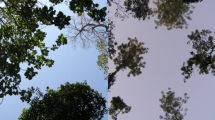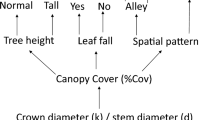Abstract
Previous studies have shown that shade trees in cacao and coffee are important habitats for inter-American migratory birds. A survey of 21 cacao farmers along the northern, central, and southern Pacific Coast of Ecuador found that shade trees are associated with unirrigated, traditional cacao varieties and low levels of chemical inputs. Farmers stressed the importance of shade for managing soil moisture and soil fertility, and for managing some weeds and diseases. Most of the shade trees were not wild forest trees, but had been planted and protected by the farm families. Many other trees are intercropped with cacao for economic reasons, not related to shade. Chocolate manufacturers, consumers, and environmental activists can encourage farmers to maintain shade canopies by paying a premium for the traditional, shade-loving, high-quality aromatic cocoa varieties.
Similar content being viewed by others
REFERENCES
Adeyemi, A. A. (1999). Effective intercropping systems for young cocoa. Tropical Science 39: 1-10.
Andall, R. P. (1999). An assessment of the production and marketing systems of sapodilla (Manilkara zapota) in Grenada. Tropical Fruits Newsletter 31: 7-10.
Arosemena, G. (1991). El Fruto de los Dioses: El Cacao en el Ecuador, desde la Colonia hasta el Ocaso de su Industria, 1600–1983, 2 Vols., Editorial Graba, Guayaquil, Ecuador.
Aulong, S., Duray, S., and Temple, L. (2000). Dynamique et structure floristique des agroforets a agrumes au centre du Cameroun. Fruits Paris 55(2): 103-114.
Baker, P. S., Bentley, J., Charveriat, C., Duque, H., Lefroy, J., and Munyua, H. (2001). The coffee smallholder. In Baker, P. (ed.), Coffee Futures: A Source Book of Some Critical Issues Confronting the Coffee Industry, CABI Commodities, Egham, UK, pp. 26-43.
Beer, J. (1987). Advantages, disadvantages and desirable characteristics of shade trees for coffee, cacao and tea. Agroforestry Systems 5: 3-13
Beer, J., Muschler, R., Kass, D., and Somarriba, E. (1998). Shade management in coffee and cacao plantations. Agroforestry Systems 38: 139-164.
Berry, W. (1990). What Are People for? North Point Press, San Francisco, CA.
Boa, E., Bentley, J., and Stonehouse, J. (2000). Cacao and neighbour trees in Ecuador: How and why farmers manage trees for shade and other purposes. Final Technical Report. CABI Bioscience, Egham, UK.
Botero, J. E., and Baker, P. S. (2001). Coffee and biodiversity: A producer-country perspective. In Baker, P. (ed.), Coffee Futures: A Source Book of Some Critical Issues Confronting the Coffee Industry, CABI Commodities, Egham, UK, pp. 94-103.
CABI (1999). Crop Protection Compendium: Global Module (Compact Disk). CABI, Wallingford, UK.
Conelly, W. T., and Chaiken, M. S. (2000). Intensive farming, agro-diversity, and food security under conditions of extreme population pressure in western Kenya. Human Ecology 28: 19-51.
Constance, D. H., Bonanno, A., and Heffernan, W. D. (1995). Global contested terrain: The case of the tuna–dolphin controversy. Agriculture and Human Values 12: 19-33.
Duguma, B., Gockowski, J., and Bakala, J. (2001). Smallholder cacao (Theobroma cacao Linn.) cultivation in agroforestry systems of West and Central Africa: Challenges and opportunities. Agroforestry Systems 51: 177-188.
Duguma, B., Tonye, J., and Depommier, D. (1990). Diagnostic survey on local multipurpose trees/shrubs, fallow systems and livestock in Southern Cameroon: IRA/ICRAF collaborative agroforestry project. In ICRAF-Working-Paper No. 60.
Estrada, A., Coates-Estrada-R, R., and Meritt, D. A., Jr. (1997). Anthropogenic landscape changes and avian diversity at Los Tuxtlas, Mexico. Biodiversity and Conservation 6: 19-43.
Gentry, A. H. (1996). A Field Guide to the Families and Genera of Woody Plants of Northwest South America (Colombia, Ecuador, Peru) with Supplementary Notes on Herbaceous Taxa, University of Chicago Press, Chicago.
Goodman, D. (2000). Organic and conventional agriculture: Materializing discourse and agro-ecological managerialism. Agriculture and Human Values 17: 215-219.
Greenberg, R. (1998). Biodiversity in the cacao agroecosystem: Shade management and landscape considerations. In Smithsonian Migratory Bird CenterCocoa Workshop in Panama. Smithsonian Migratory Bird Center/Smithsonian Tropical Research Institute, Panama. http://natzoo.si.edu/smbc/Research/cacao/cacao.htm.
Guptill, A., and Wilkins, J. L. (2002). Buying into the food system: Trends in food retailing in the U.S. and implications for local foods. Agriculture and Human Values 19: 39-51.
Hecht, S. B. (1982). Agroforestry in the Amazon Basin: Practice, theory and limits of a promising land use. In Hecht, S.B. (ed.), Land Use and Agricultural Research in the Amazon Basin, CIAT, Cali, Colombia, pp. 331-371.
Herzog, F. (1994). Multipurpose shade trees in coffee and cocoa plantations in Cote d'Ivoire. Agroforestry Systems 27: 259-267.
Iskandar, J., and Ellen, R. F. (2000). The contribution of Paraserianthes (Albizia) falcataria to sustainable swidden management practices among the Baduy of West Java. Human Ecology 28: 1-17.
Krauss, U., Soberanis, W., Muschler, R., and Beer, J. (2001) Rehabilitation of diseased cacao fields in Peru through shade regulation and timing of biocontrol measures. Agroforestry Systems 53: 179-184.
Kricher, J. C. (1989). A Neotropical Companion, Princeton University Press, Princeton, NJ.
Medellin, R. A, Equihua, M., and Amin, M. A. (2000). Bat diversity and abundance as indicators of disturbance in Neotropical rainforests. Conservation Biology 14: 1666-1675.
Meregini, A. O. A. (1997). Timber production in cocoa based agroforestry systems in parts of Abia State Nigeria. In Oduwaiy, E. A., Obiaga, P. C., and Abu, J. E. (eds.), Environment and Resource Development. Proceedings of the 25th Annual Conference of the Forestry Association of Nigeria, Ibadan, Oyo State, Nigeria, September 22–26, 1997.
Mussack, M. (1988). DiagnÓstico SocioeconÓmico de los Sistemas Agroforestales de Cacao, Café y árboles de Sombra Utilizados en la ProducciÓn de Madera en la Costa de Ecuador. In FPEI Working Papers Series No. 35.
Netting, R. M. (1993). Smallholders, Householders: Farm Families and the Ecology of Intensive, Sustainable Agriculture, Stanford University Press, Stanford, CT.
Odum, E. P. (1959). Fundamentals of Ecology, 2nd edn., Saunders, Philadelphia.
Oladokun, M. A. O. (1990). Tree crop based agroforestry in Nigeria: A checklist of crops intercropped with cocoa. Agroforestry Systems 11: 227-241.
Parrish, J. (1998). Cacao as crop and conservation tool: Lessons from the Talamanca Region of Costa Rica. In Smithsonian Migratory Bird Center Cocoa Workshop in Panama. Smithsonian Migratory Bird Center/Smithsonian Tropical Research Institute, Panama. http://natzoo.si.edu/smbc/Research/cacao/cacao.htm.
Power, A. G., and Flecker, A. S. (1998). Agroecosystems and biodiversity. In Smithsonian Migratory Bird Center Cocoa Workshop in Panama. Smithsonian Migratory Bird Center/Smithsonian Tropical Research Institute, Panama. http://natzoo.si.edu/smbc/Research/cacao/cacao.htm.
Proyecto Cacao (1997). Principales Características de los Sistemas de ProducciÓn de Cacao en la Zona de Alcance del Proyecto (Encuestas Realizadas entre Mayo y Noviembre de 1996), Documento del Proyecto No. 22. Proyecto ECU-B7-3010/93/176, ReactivaciÓn de la ProducciÓn y Mejora de la Calidad del Cacao en Ecuador, Guayaquil.
Quiroz, J. (1997). RecolecciÓn de Genotipos y Establecimiento de un Banco de Germosplama de Cacao Nacional en Ecuador. Instituto Nacional AutÓnomo de Investigaciones Agropecuarias, EstaciÓn Experimental Tropical Pichilingue, Quevedo, Ecuador.
Ramírez, O. A., and Somarriba, E. (2000). Risk and returns of diversified cropping systems under non-normal, cross-, and auto-correlated commodity price structures. Journal of Agricultural and Resource Economics 25: 653-668.
Ramírez, O. A., Somarriba, E., Ludewigs, T., and Ferreira, P. (2001). Financial returns, stability and risk of cacao–plantain–timber agroforestry systems in Central America. Agroforestry Systems 51: 141-154.
Raynolds, L. T. (2000). Re-embedding global agriculture: The international organic and fair trade movements. Agriculture and Human Values 17: 297-309.
Reitsma, R., Parrish, J. D., McLarney, W., Mack, R., Lynch, J., Chavarría, C. R., Bustles, R., and Rodríguez, W. (1999). The role of cacao plantations in maintaining avian diversity in Southeastern Costa Rica. In Jiménez, F., and Beer, J. (eds.), Multistrata Agroforestry Systems With Perennial Crops, CATIE, Turrialba, Costa Rica.
Rice, R. A., and Greenberg, R. (2000). Cacao cultivation and the conservation of biological diversity. Ambio 29: 167-173.
Reitsma, R, Parrish, J. D., McLarney, W., Muschler, R., and Beer, J. (2001). The role of cacao plantations in maintaining forest avian diversity in southeastern Costa Rica. Agroforestry Systems 53: 185-193.
Roseberry, W. (1996). The rise of yuppie coffees and the reimagination of class in the United States. American Anthropologist 98: 762-775.
Schulz, B., Becker, B., and Eotsch, E. (1994). Indigenous knowledge in a "modern" sustainable agroforestry system: A case study from eastern Brazil. Agroforestry Systems 25: 59-69.
Siebert, S. F. (2000). Survival and growth of rattan intercropped with coffee and cacao in the agroforests of Indonesia. Agroforestry Systems 50: 95-102.
Smithsonian Migratory Bird Center (1998). Cocoa Workshop in Panama. Smithsonian Migratory Bird Center/Smithsonian Tropical Research Institute, Panama. http://natzoo.si.edu/smbc/Research/cacao/cacao.htm.
Somarriba, E., Valdivieso, R., Vásquez, W., and Galloway, G. (2001). Survival, growth, timber productivity and site index of Cordia alliodora in forestry and agroforestry systems. Agroforestry Systems 51: 111-118.
Valverde, F. M. (1998). Plantas útiles del Litoral Ecuatoriano, Ministerio de Medio Ambiente, Guayaquil.
van Elzakker, B. (2001). Organic coffee. In Baker, P. (ed.), Coffee Futures: A Source Book of Some Critical Issues Confronting the Coffee Industry, CABI Commodities, Egham, UK, pp. 74-81.
Vandermeer, J. H., and Perfecto, I. (1998). Biodiversity and pest control in agroforestry systems. Agroforestry Forum 9: 2-6.
Whinney, J. (1998). Considerations for the sustainable production of cocoa. In Smithsonian Migratory Bird Center Cocoa Workshop in Panama. Smithsonian Migratory Bird Center/Smithsonian Tropical Research Institute, Panama. http://natzoo.si.edu/smbc/Research/cacao/cacao.htm.
Willson, K. C. (1999). Coffee, Cocoa and Tea, CABI, Wallingford, UK.
Wilken, G. C. (1987). Good Farmers: Traditional Agricultural and Resource Management in Mexico and Central America, University of California Press, Berkeley.
Author information
Authors and Affiliations
Corresponding author
Rights and permissions
About this article
Cite this article
Bentley, J.W., Boa, E. & Stonehouse, J. Neighbor Trees: Shade, Intercropping, and Cacao in Ecuador. Human Ecology 32, 241–270 (2004). https://doi.org/10.1023/B:HUEC.0000019759.46526.4d
Issue Date:
DOI: https://doi.org/10.1023/B:HUEC.0000019759.46526.4d




